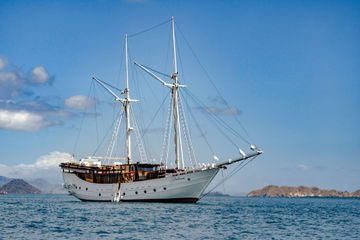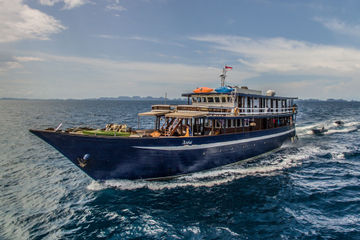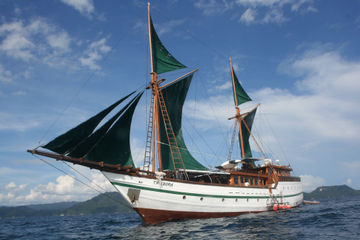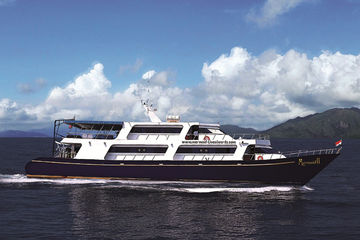Popular Togian Islands liveaboards Explore all liveaboards
Liveaboard Diving in Togian Islands
What to Expect On a Togian Islands Liveaboard
This group of islands is relatively inaccessible, therefore the best way to sample the incredible diving here is by a Togian Islands liveaboard. The Togian Islands are an archipelago (a group or cluster of islands) situated in the Gulf of Tomini. At its widest, the Tomini Gulf stretches to 200 km and is a staggering 4 km deep in the Gorontalo Trough. The archipelago was originally formed by volcanic activity, and consists of 3 main islands, Togean, Batudaka and Unauna as well as around 60 other small islands. In 2004, the islands were given the protection of a national park status, limiting many fishing activities. Numerous Indonesian liveaboards offer itineraries to this amazing area.
Currents are usually very gentle around the islands, largely sheltered by the mainland of the Gulf. The tropical climate means liveaboard diving in the Togian Islands is an all year round activity with water temperatures between 80 and 86 Fahrenheit (27 - 30C), although the best times to visit are during the dry season from March until December. Visibility remains at a consistent 65 to 130 feet (20 - 40 m), great for achieving good light conditions for photographers.
Togian Islands Underwater
Most dives here are wall dives, and with gentle currents, the diving is particularly easy. Species diversity is something to behold, with 819 species of fish, 541 mollusc species, and 314 species of coral. The islands offer quite a variety of reef systems, including a huge barrier reef to the north that stretches from either end of the Togian Islands. Nearby mangroves provide a safe area for many species to breed, including the hawksbill turtle, green turtle, and even dugongs!
Dive Sites of Togian Islands
A variety of dive sites in the Togian Islands are accessible on a liveaboard cruise, some sites that may be visited are listed below;
On 3 May 1945, a WWII bomber, the B24 Liberator was returning to base, located on the island of Morotai. However, a fire in the engine broke, leaving the crew no choice but to attempt an extremely risky landing on the surface of the sea. As a testament to the skill of the pilot, all crew survived the incident, and have left a wreck in absolutely fantastic condition. The wings and tail are all intact, and even a prop remains. Swimming alongside the 55 foot (17 m) long, 72 foot (22 m) wide wreck, it is still possible peer into the cockpit to see the pilotís seat and flight instrumentation. Schools of jacks are prolific around the bomber, now sitting on a sandy bed between 50 and 80 feet (16 - 24 m). Crocodile fish lie in wait along the bottom, while all around the wreck are glassfish and the occasional patrolling oceanic whitetip shark.
Pulau Unauna is a volcanic island offering perhaps some of the best diving in the Togian Islands. Sponges are particularly abundant here, of all sizes and wonderfully intricate shapes. There are two main dive sites here, The Pinnacle, located to the east of Unauna, and Apollo, found on the southeast side of the island. The Pinnacle offers an amazing liveaboard dive, with a pinnacle that's so big it essentially becomes a wall dive, dropping to 196 feet (60 m). All sorts of soft coral formations are found here, from barrels and cones to tubes and vases, in a wide arrangement of colours. Turtles, especially, are attracted to the site by the corals which they feed upon.
The second site of interest, Apollo, consists of patchy reefs on a sand bed. The depths range from 70 to 148 feet (21 to 45 m) and is where youíll find the larger, pelagic species. Huge schools of barracuda usually occupy this area, including Napoleon Wrasse, and moray eels.
Batu Gila is another astounding dive along the top of an 80 foot (25 m) wide ridge, with huge drop-offs on either side. The ridge varies in depth, down to a maximum of 138 feet (42 m), and is exposed to fairly strong currents. Large tuna, manta rays, and even hammerheads can be found here.
Top Tips For Divers
Many of the dives in the Togian Islands are wall dives, and visibility is consistently high. Although this is very often an attractive feature, it can sometimes lead to divers losing their reference of depth. It is very important to frequently monitor your dive computer or depth gauge to ensure you remain no deeper than intended.
Getting to Togian Islands
Indonesian liveaboards who voyage to the volcanic Togian Islands typically leave directly from Manado. Manado also has an international airport that is becoming fairly easy to reach as the number of airlines offering direct flights are increasing. At the moment though, most people traveling from afar tend to connect via Singapore.
If your Togian Islands dive cruise leaves directly from the Togian Islands, you should fly to Luwuk (a small airport situated on the other side of the Tomini Gulf) after arriving in Manado International Airport. From here, it is a relatively straightforward journey to the ports of either Ampana or Gorontalo, where you can catch a ferry to one of the main islands. However, departure schedules for the ferries are not always reliable, as the ferries need calm water to cross and are occasionally subject to mechanical breakdowns. It can be more convenient to charter a boat instead.




.jpg?tr=w-360,h-240)







